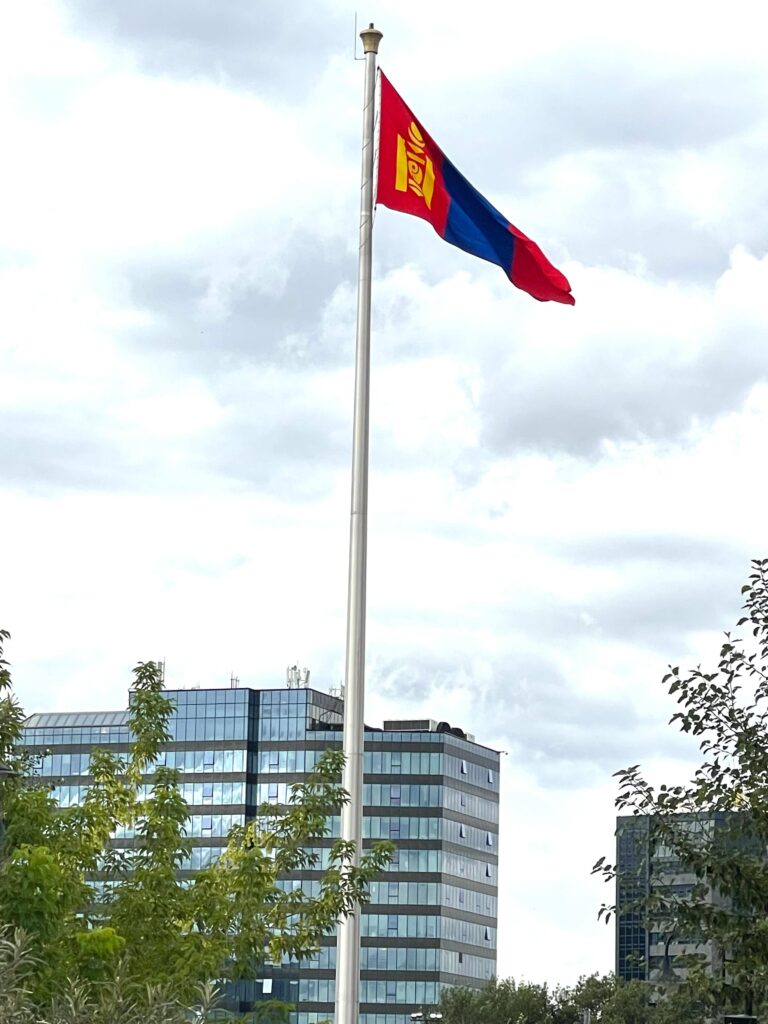The flag in Mongolia is more than just a symbol fluttering in the wind — it’s a visual story of independence, resilience, and identity. From the blazing red of its stripes to the mysterious Soyombo emblem that crowns its design, the Mongolian flag reflects centuries of history and culture. Whether you’re visiting the vast steppes, watching the Naadam Festival, or exploring the bustling streets of Ulaanbaatar, you’ll see this flag waving proudly everywhere.
Here are 10 fascinating facts about the flag in Mongolia that reveal its deeper meaning and evolution.
1. The Flag’s Design Is Simple — Yet Deeply Symbolic
The flag of Mongolia consists of three vertical bands: red, blue, and red. The blue represents the eternal sky — a sacred element in Mongolian culture — while the red stripes symbolize progress and prosperity. On the left red stripe stands the Soyombo, an ancient symbol representing freedom and independence.
2. The Soyombo Is Not Just a Symbol — It’s an Ancient Script
The Soyombo symbol on the flag comes from a script invented by Zanabazar, a 17th-century spiritual leader and scholar. It serves as both a writing system and a philosophical emblem.

The Soyombo emblem is not just decorative — it comes from a writing system created by Zanabazar, a 17th-century monk and philosopher. Every part has meaning:
- 🔥 Fire: Growth and prosperity
- ☀️🌙 Sun and moon: Eternity
- 🔻 Triangles: Defense against enemies
- ⚖️ Yin-yang: Balance and harmony
Together, these symbols tell the story of the Mongolian worldview.
3. The Current Flag Was Adopted in 1992
Mongolia’s current flag was officially adopted on February 12, 1992, following the country’s democratic revolution. The earlier version included a socialist star above the Soyombo, which was removed after the fall of communism. The redesign marked a new era of freedom and independence.
4. The Flag’s Blue Center Represents “Tenger” — the Eternal Sky
In Mongolian belief, Tenger, or the Eternal Blue Sky, is a divine force that protects the land and its people. The flag’s deep blue stripe pays homage to this ancient spiritual tradition, connecting the modern nation to its nomadic and shamanistic roots.
5. The Red Stripes Stand for Strength and Progress
Red has long symbolized courage, vitality, and progress in Mongolian culture. Historically, it also reflects the sacrifices of warriors who defended the land throughout centuries of conquest and freedom struggles. Together, the red stripes frame the eternal blue — strength protecting spirit.
6. The Flag Is Always Raised with Great Respect
When traveling in Mongolia, you’ll notice that the flag is treated with deep reverence. It is raised at government buildings, schools, and during national holidays such as Naadam (the Festival of the Three Manly Sports). On these occasions, Mongolians proudly wear traditional attire as the flag waves high against the steppe sky.

7. The Soyombo Appears in Many National Symbols
You’ll find the Soyombo not only on the flag but also on Mongolia’s coat of arms, currency, passports, and even military insignia. It is so iconic that it has become the official national emblem, symbolizing unity and resilience across all aspects of Mongolian identity.
8. The Flag Was Once Banned During the Qing Dynasty
During the Qing rule (17th–20th centuries), Mongolia’s national symbols were suppressed. The Soyombo, associated with independence, was forbidden. It re-emerged proudly in 1911 when Mongolia declared independence — and later became central to the flag’s design after the 1921 revolution.
9. The Flag Represents Both Modernity and Nomadic Heritage
While the flag’s modern design is sleek and minimal, its elements — sky, fire, balance — come directly from nomadic philosophy. It bridges ancient shamanistic beliefs with a modern democratic identity, reminding Mongolians of their roots wherever they go.
10. The Flag Is a Source of National Unity
For Mongolians, the flag is not just a state symbol — it’s a spiritual anchor. Whether displayed on yurts (gers) in the countryside or atop high-rise buildings in Ulaanbaatar, it embodies a shared pride that transcends generations. The flag unites Mongolians under the same eternal sky, just as it did for their ancestors.
🏞️ Where You’ll See the Flag in Mongolia
- At Sükhbaatar Square, Ulaanbaatar’s main plaza, where it waves beside a statue of the revolutionary hero.
- During Naadam Festival, when athletes compete in wrestling, archery, and horse racing under its colors.
- On mountain peaks and monasteries, often tied alongside blue khadag (ceremonial scarves).
- In every aimag (province) capital and rural schoolyard — a proud reminder of national unity.
🇲🇳 The Flag in Mongolia — A Living Symbol of Freedom
From the golden flames of the Soyombo to the sky-blue stripe at its heart, the flag in Mongolia captures the nation’s enduring spirit. It tells a story of survival, transformation, and faith in freedom. When you see it waving over the Mongolian steppe, you’re witnessing more than a national emblem — you’re seeing the soul of a country.
Learn about more top attractions in Mongolia and what to visit in Mongolia in our Mongolia travel guide.